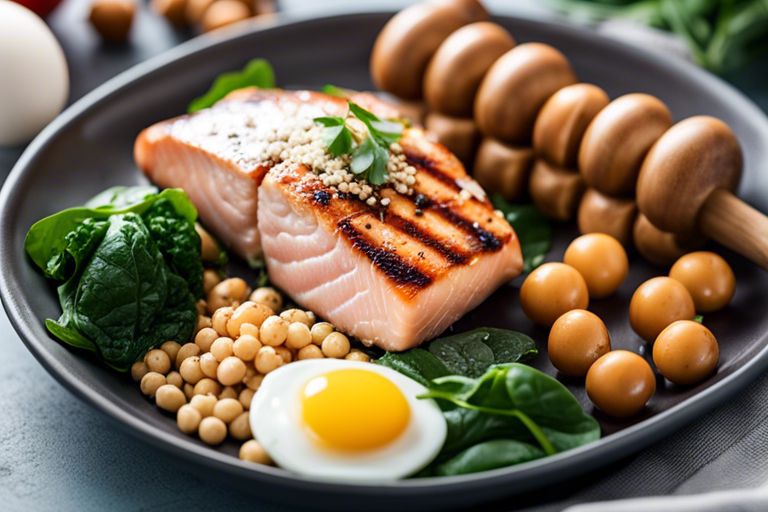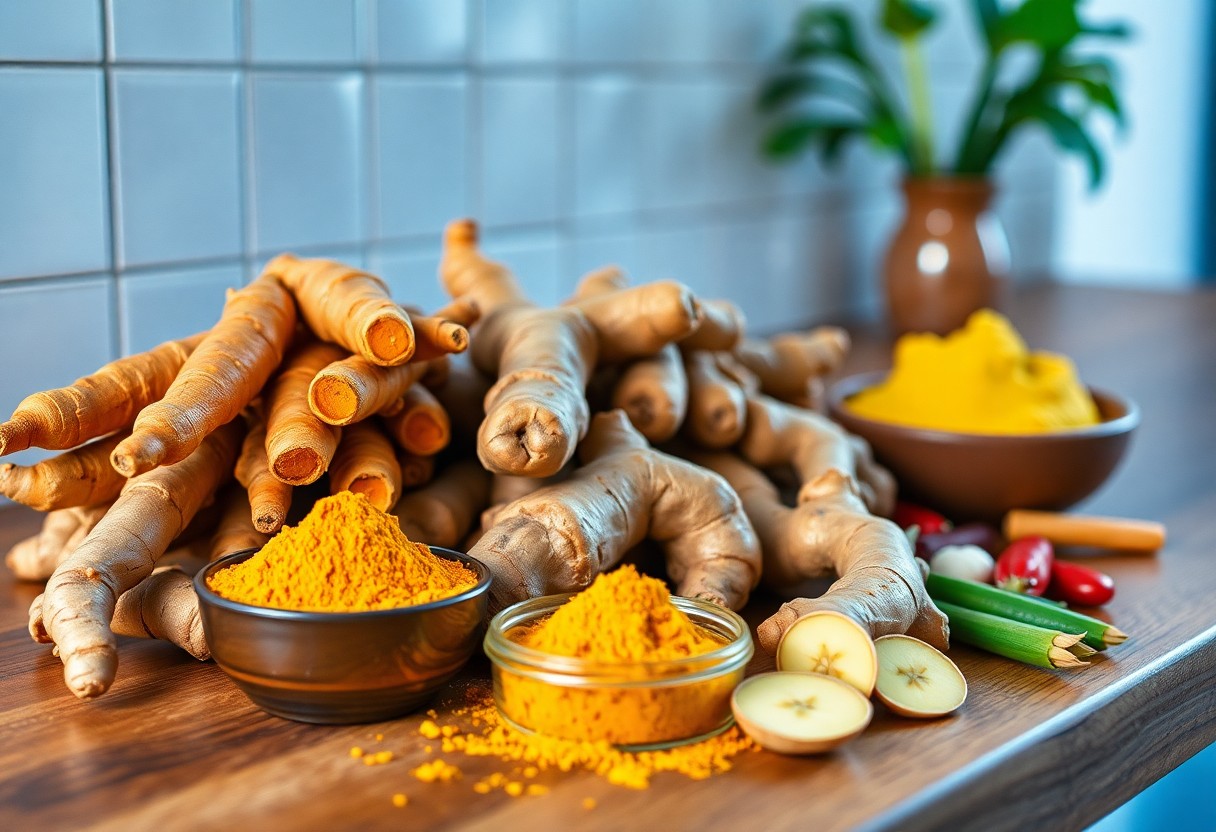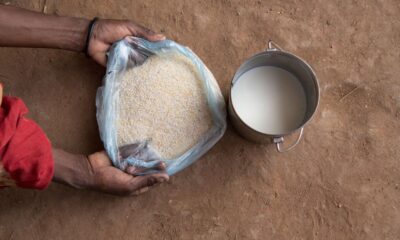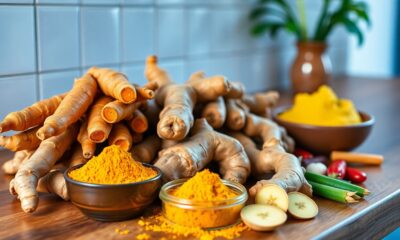Health & Society
The Best Foods To Eat For Muscle Recovery And Growth

Overwhelmed with the endless options in the grocery store? In the context of fueling your muscles for recovery and growth, the right foods can make all the difference. Incorporating protein-packed choices like chicken, eggs, and Greek yogurt into your diet can help repair and build muscle tissue. Don’t forget about healthy fats from sources like avocados and nuts to support muscle function. Amp up your meals with colorful fruits and vegetables for added antioxidants to reduce inflammation. Be mindful of, what you eat plays a significant role in your fitness journey.
1. Protein-rich foods aid muscle recovery and growth.
2. Complex carbohydrates fuel muscles and replenish glycogen stores.
3. Omega-3 fatty acids reduce inflammation and support muscle repair.
4. Colorful fruits and vegetables provide imperative vitamins and minerals.
5. Greek yogurt promotes muscle protein synthesis.
6. Hydration with water is crucial for muscle recovery.
Macronutrients for Muscle Recovery and Growth
The Importance of Protein
With protein being the building block of muscle tissue, it plays a crucial role in muscle recovery and growth. When you consume protein-rich foods, you provide your body with the important amino acids needed to repair and build muscle fibers. Aim to include a source of lean protein in every meal to support your muscle-building goals.
The Role of Carbohydrates
For muscle recovery and growth, carbohydrates are important as they replenish glycogen stores that are depleted during intense workouts. Including complex carbohydrates such as whole grains, fruits, and vegetables in your diet provides you with sustained energy to fuel your workouts and support muscle recovery.
It’s important to note that not all carbohydrates are created equal. Opt for nutrient-dense sources like sweet potatoes, quinoa, and oats, which provide vitamins, minerals, and fiber along with energy.
Healthy Fats for Muscle Function
On top of protein and carbohydrates, healthy fats are also important for muscle function. Foods rich in omega-3 fatty acids such as salmon, flaxseeds, and walnuts help reduce inflammation in the body, which can aid in recovery. Including sources of healthy fats in your diet supports overall muscle health and function.
Plus, don’t skimp on fats as they are crucial for absorbing fat-soluble vitamins like vitamins A, D, E, and K, which are important for overall health and muscle recovery.
Post-Workout Nutrition
Little do you know, post-workout nutrition is a crucial aspect of your fitness journey. What you eat after a workout can significantly impact your muscle recovery and growth. Paying attention to your post-workout nutrition can help you maximize the benefits of your hard work at the gym.
Timing is Everything
PostWorkout: The window of opportunity for optimal muscle recovery and growth is within the first 30 minutes to an hour after your workout. During this time, your body is primed to absorb nutrients and replenish glycogen stores. Make sure to have a post-workout meal or snack ready to consume soon after your training session to kickstart the recovery process.
What to Eat After a Workout
To: After a strenuous workout, your body needs a combination of protein and carbohydrates to repair and replenish muscles. Include sources of lean protein such as chicken, fish, or tofu, along with complex carbohydrates like whole grains, sweet potatoes, or fruits. This nutrient combination will help promote muscle protein synthesis and glycogen resynthesis, aiding in muscle recovery and growth.
Another imperative factor to consider for muscle recovery is hydration. Dehydration can hinder your body’s ability to repair and rebuild muscle tissue. Aim to drink plenty of water throughout the day, especially before and after your workout, to support optimal recovery.
Hydration for Recovery
On: Hydrating properly after a workout is key to replenishing fluids lost through sweating and supporting muscle recovery. In addition to water, consider incorporating electrolyte-rich beverages or coconut water to replenish vital minerals lost during exercise. Proper hydration will help you recover faster and perform better during your next workout.
Protein-Rich Foods for Muscle Growth
Keep your muscles fueled and growing strong with protein-rich foods that are necessary for muscle recovery and growth. Including a variety of sources in your diet can help you reach your fitness goals faster.
Lean Meats: Chicken, Turkey, and Fish
An excellent source of high-quality protein, lean meats like chicken, turkey, and fish are necessary for muscle building. They are low in saturated fats and rich in nutrients that support muscle recovery and growth. Including these lean meats in your meals can help you maintain a lean physique while providing the necessary protein for muscle repair and growth.
Eggs: The Ultimate Muscle-Building Food
Fish not only packed with protein but also contain necessary amino acids that are crucial for muscle repair and growth. The high-quality protein found in eggs makes them a staple in many bodybuilders’ diets. Including eggs in your diet can help you meet your daily protein requirements for optimal muscle-building results.
MuscleBuilding: Eggs are versatile and easy to include in your meals, whether you prefer them boiled, scrambled, or as part of a protein-rich omelet. Make eggs a regular part of your diet to support your muscle-building goals.
Legumes: Beans, Lentils, and Peas
Food rich in protein and fiber, legumes like beans, lentils, and peas are excellent plant-based sources of protein for muscle growth. They also contain necessary vitamins and minerals that support overall health and well-being. Including a variety of legumes in your meals can help you increase your protein intake and support muscle recovery after intense workouts.
The fiber content in legumes can also aid in digestion and help you feel full longer, making them a great addition to your diet if you are looking to build muscle while maintaining a healthy weight.
Complex Carbohydrates for Energy
Your muscle recovery and growth heavily rely on the fuel you provide your body. Consuming complex carbohydrates is imperative for sustained energy levels during your workouts and aiding in muscle repair post-exercise.
Whole Grains: Brown Rice, Quinoa, and Oats
The whole grains like brown rice, quinoa, and oats are excellent sources of complex carbohydrates that release energy slowly, providing a steady stream of fuel for your muscles. These grains are also packed with fiber, vitamins, and minerals, aiding in digestion and overall health.
Fruits: Bananas, Berries, and Citrus
Grains are not the only source of complex carbohydrates for your muscle recovery. Fruits such as bananas, berries, and citrus fruits are rich in carbohydrates and imperative vitamins and minerals that help replenish glycogen stores in muscles, promoting faster recovery and growth.
Additionally, fruits are high in antioxidants, which can reduce inflammation and oxidative stress caused by intense workouts, further supporting muscle repair and overall health.
Vegetables: Leafy Greens, Broccoli, and Sweet Potatoes
Whole grains and fruits are vital, but don’t overlook the power of vegetables in your diet for muscle recovery. Incorporating leafy greens like spinach, nutrient-dense broccoli, and complex carbohydrates-rich sweet potatoes can provide your body with imperative vitamins, minerals, and antioxidants needed for optimal muscle function and growth.
Moreover, vegetables are low in calories but high in nutrients, making them a perfect addition to your meals for supporting muscle recovery without compromising your overall calorie intake.
Celebrate the diversity of Quinoa, a complete protein source and complex carbohydrate that is gluten-free and rich in fiber. It helps in regulating blood sugar levels, aiding in sustained energy release needed for your workouts and muscle recovery.
Healthy Fats for Hormone Regulation
Despite the common misconception that all fats are bad for you, incorporating healthy fats into your diet is vital for hormone regulation, especially when it comes to muscle recovery and growth. Healthy fats play a crucial role in supporting overall health and maintaining optimal hormone levels, which are vital for muscle building and repair.
Nuts and Seeds: Almonds, Walnuts, and Chia Seeds
An excellent source of healthy fats to include in your diet is nuts and seeds such as almonds, walnuts, and chia seeds. These superfoods are packed with omega-3 fatty acids, which are known for their anti-inflammatory properties and hormone-regulating effects. By adding a handful of nuts or seeds to your meals or snacks, you can support your muscle recovery and growth while keeping your hormones in check.
Avocados: The Ultimate Healthy Fat Source
One of the best sources of healthy fats that you can incorporate into your diet is avocados. Avocados are rich in monounsaturated fats, which are vital for hormone production and regulation. Additionally, they are packed with fiber and various vitamins and minerals that support overall health. Adding avocados to your salads, sandwiches, or as a topping for your meals can help promote muscle recovery and growth.
Source: Avocados are also a great source of potassium, which is crucial for muscle function and recovery. Including avocados in your diet can help replenish electrolytes lost during intense workouts, supporting muscle recovery and growth.
Fatty Fish: Salmon, Tuna, and Mackerel
Fatty fish such as salmon, tuna, and mackerel are excellent sources of omega-3 fatty acids, which are vital for hormone regulation and reducing inflammation in the body. These healthy fats not only support muscle recovery and growth but also help improve overall heart health and brain function. Including fatty fish in your diet a few times a week can have significant benefits for your hormones and muscle-building efforts.
Nuts: To ensure you are getting an adequate amount of healthy fats in your diet, try incorporating a variety of nuts, seeds, avocados, and fatty fish into your meals. These foods not only taste delicious but also provide vital nutrients that support your muscle recovery and growth goals.
Meal Frequency and Timing
Once again, meal frequency and timing play a crucial role in supporting muscle recovery and growth.
Eating for Muscle Recovery: How Often and When
Eating at regular intervals throughout the day can help fuel your muscles and provide a steady supply of nutrients for optimal recovery. Aim to have a balanced meal or snack every 3-4 hours to keep your energy levels stable and support muscle repair.
The Importance of Breakfast for Muscle Growth
For muscle growth, breakfast is an necessary meal that sets the tone for the rest of the day. Starting your day with a nutritious breakfast helps kickstart your metabolism and provides your muscles with the necessary nutrients after a night of fasting. Include sources of protein, carbs, and healthy fats to fuel your body for the day ahead.
Muscle growth is most active during sleep, and breakfast helps replenish glycogen stores and provides amino acids for muscle repair. Skipping breakfast can lead to muscle breakdown and sluggishness throughout the day, hindering your progress in the gym.
Snacking for Muscle Recovery
Snacking strategically between meals can support muscle recovery by preventing energy crashes and keeping your metabolism revved up. Choose nutrient-dense snacks like Greek yogurt, nuts, or a protein shake to provide your muscles with a quick source of energy and amino acids.
Muscle recovery is a continuous process, and snacking on the right foods can help maintain a constant supply of nutrients for your muscles to repair and grow. Avoid sugary snacks and opt for protein-rich options to support your fitness goals effectively.
Supplements for Muscle Recovery and Growth
After a strenuous workout, your muscles need proper nutrition to recover and grow stronger. In addition to a well-rounded diet, supplements can play a crucial role in supporting your muscle-building goals. Here are some important supplements to consider incorporating into your routine:
Protein Powder: Whey, Casein, and Plant-Based Options
Muscle protein synthesis is important for muscle recovery and growth, and protein powders can be a convenient way to increase your daily protein intake. Whey protein is fast-absorbing and ideal for post-workout recovery, while casein protein is slower-digesting and great for supporting muscle repair overnight. For those following a plant-based diet, plant-based protein powders like pea, hemp, or rice protein can be excellent alternatives.
Creatine: The Ultimate Muscle-Building Supplement
Supplementing with creatine is a popular choice among athletes and fitness enthusiasts for its proven ability to enhance strength, power, and muscle size. A daily creatine supplement can increase your body’s phosphocreatine stores, allowing for more energy production during high-intensity workouts. This can lead to greater muscle gains and improved performance in the gym.
A proper creatine supplementation protocol typically involves a loading phase to saturate your muscles with creatine, followed by a maintenance phase to keep levels elevated. Remember to drink plenty of water while taking creatine to ensure optimal hydration levels.
Branched-Chain Amino Acids (BCAAs) for Recovery
On your quest for muscle recovery, don’t overlook the importance of Branched-Chain Amino Acids (BCAAs). These important amino acids, including leucine, isoleucine, and valine, play a significant role in protein synthesis and muscle repair. Taking BCAAs before, during, or after your workout can help reduce muscle soreness, decrease exercise fatigue, and support muscle growth. Plus, they can be a flavorful addition to your water during workouts!

Hydration for Muscle Recovery
To optimize your muscle recovery and growth, proper hydration is key. Dehydration can hamper your performance and delay the healing process of your muscles after a tough workout. Here are some tips to ensure you are staying properly hydrated for muscle recovery.
Water: The Ultimate Recovery Drink
On top of your list should be water, the ultimate recovery drink. Staying hydrated is important for maintaining optimal muscle function. Drinking enough water helps transport important nutrients to your muscles, aids in digestion, and regulates your body temperature, all of which are crucial for muscle recovery.
Electrolytes: Why You Need Them
Muscle recovery is also dependent on maintaining the right balance of electrolytes in your body. These minerals, such as sodium, potassium, magnesium, and calcium, play a vital role in muscle contractions, nerve function, and fluid balance. When you sweat during intense workouts, you lose electrolytes that need to be replenished to support muscle recovery.
Plus, electrolytes help your body absorb and retain the water you drink, ensuring you stay properly hydrated. Including sources of electrolytes in your post-workout routine can help accelerate muscle recovery and prevent cramping and fatigue.
Coconut Water: A Natural Recovery Drink
One excellent source of both hydration and electrolytes is coconut water. It is a natural and refreshing way to replenish electrolytes lost during exercise, making it a great post-workout beverage choice. Coconut water is rich in potassium, magnesium, and other important minerals, making it an ideal option to support muscle recovery and hydration.
Foods to Avoid for Muscle Recovery and Growth
To make the most out of your muscle recovery and growth, it’s crucial to pay attention not only to what you should eat but also to what you should avoid. In your journey to building stronger muscles, steering clear of certain foods can help boost your progress and performance. For a comprehensive guide on the best foods to eat for muscle recovery and growth, check out the 10 Best Muscle Recovery Foods recommended by experts.
Processed Meats: Hot Dogs, Sausages, and Bacon
Any fitness enthusiast knows that processed meats like hot dogs, sausages, and bacon are convenient but **not** the best choice for muscle recovery and growth. These items are typically high in saturated fats, sodium, and additives that can hinder your progress. Consuming **strong** levels of processed meats can lead to **inflammation** in the body, which ultimately impacts your recovery time and muscle development.
Sugary Drinks: Soda, Sports Drinks, and Juice
On your quest for muscle recovery and growth, it’s necessary to be mindful of the beverages you consume. **Sugar**-laden drinks like soda, sports drinks, and juice can sabotage your efforts. These beverages are full of **empty** calories that provide little to no nutritional value. **Regular** consumption of sugary drinks can spike your blood sugar levels, leading to energy crashes and **diminished** performance during your workouts.
Understanding the detrimental effects of sugary drinks on your muscle recovery and growth is crucial. **Excess** sugar intake can hinder protein synthesis, which is necessary for building and repairing muscles. Opting for **hydration**-boosting options like water, coconut water, or **unsweetened** herbal teas is a smarter choice to support your fitness goals.
Refined Carbohydrates: White Bread, Pasta, and Sugary Snacks
Refined carbohydrates, including white bread, pasta, and sugary snacks, can impede your muscle recovery and growth **progress**. These items are **high** in simple sugars and low in fiber and **nutrients**, causing your blood sugar levels to fluctuate **rapidly**. **Consuming** refined carbohydrates can lead to increased **fat** storage and reduced energy levels, hindering your workout performance in the long run.
Recovery from intense workouts **can** be optimized by choosing complex carbohydrates like whole grains, quinoa, and **sweet** potatoes. These options provide **sustained** energy release and are rich in **nutrients** that support muscle repair and growth. **By** prioritizing whole, unprocessed foods, you can enhance your muscle recovery and **achieve** your fitness goals more effectively.
Meal Planning for Muscle Recovery and Growth
Many athletes and fitness enthusiasts know that proper nutrition is key to muscle recovery and growth. Incorporating the right foods into your diet can make a significant difference in how your body repairs and builds muscle after intense exercise. According to 11 Best Muscle Recovery Food and Drinks, some of the top foods for muscle recovery include salmon, berries, sweet potatoes, and leafy greens.
Creating a Balanced Meal Plan
Meal planning is vital for maximizing muscle recovery and growth. You need to ensure that your meals are balanced with the right mix of protein, carbohydrates, and healthy fats to support your fitness goals. Aim to include a variety of nutrient-dense foods in your meals to provide your body with the necessary fuel for recovery and growth.
Meal Prep: Tips and Tricks
Growth starts in the kitchen, and meal prep can be a game-changer for your muscle recovery and growth goals. By taking the time to plan and prepare your meals in advance, you can ensure that you have healthy options readily available when you need them. To streamline the process, consider these meal prep tips:
- Batch cook protein sources like chicken, tofu, or lentils.
- Chop and wash fruits and vegetables for easy snacking.
- Invest in quality meal prep containers to keep your food fresh.
Recognizing the importance of meal prep in your fitness journey can help set you up for success in reaching your muscle recovery and growth goals.
Eating Out: Healthy Options for Muscle Recovery
This is where many people struggle with maintaining their nutrition goals. When you find yourself dining out, it can be challenging to make healthy choices that support your muscle recovery. However, with a little planning and awareness, you can still enjoy a meal out while staying on track with your fitness goals.
Recovery: Remember that the choices you make when eating out can impact your muscle recovery and growth progress. Look for options that include lean protein, whole grains, and plenty of vegetables to support your body’s needs. Balancing indulgences with nutrient-dense choices is key to maintaining a healthy eating plan even when dining out.
Common Mistakes to Avoid
All successful fitness journeys require not only proper nutrition and training but also avoiding common mistakes that can hinder your progress. Here are some pitfalls to watch out for:
Not Eating Enough Protein
Protein is crucial for muscle recovery and growth. One common mistake is not consuming enough protein in your diet. Protein helps repair muscle tissue that is broken down during workouts, aiding in muscle recovery and growth. Make sure to include protein-rich foods such as lean meats, eggs, dairy, legumes, and protein supplements in your meals to support your muscle-building goals.
Not Drinking Enough Water
Drinking an adequate amount of water is necessary for overall health and performance. Dehydration can lead to decreased exercise performance, muscle cramps, and hindered recovery. Aim to drink at least 8-10 glasses of water a day, and more if you’re exercising intensely or in hot weather. Proper hydration supports nutrient transport, joint lubrication, and temperature regulation in the body.
Another important aspect to consider is that other beverages like caffeinated drinks, alcohol, or sugary drinks can contribute to dehydration, so limit your intake of these beverages and prioritize water consumption.
Not Getting Enough Rest and Recovery
Mistakes can also be made when it comes to rest and recovery. Your muscles need time to repair and grow stronger after intense workouts. Not allowing enough time for rest can lead to overtraining, which can cause muscle fatigue, decreased performance, and an increased risk of injury. Make sure to prioritize quality sleep, rest days, and recovery activities like stretching or foam rolling to support your muscle growth and overall well-being.
Getting enough rest and recovery is just as important as your workouts and nutrition in achieving your fitness goals. Listen to your body and give yourself the time to recover adequately between training sessions. This way, you’ll ensure that you’re making progress in a sustainable and healthy manner.
By avoiding these common mistakes and focusing on proper nutrition, hydration, and recovery, you’ll be on the right path to maximizing your muscle growth and achieving your fitness goals.
Special Considerations for Vegetarians and Vegans
Now, when it comes to muscle recovery and growth, it’s important for vegetarians and vegans to pay attention to their protein intake. While meat is a primary source of protein for many athletes, you can still meet your protein needs through plant-based sources. Check out the 11 Best Foods for Muscle Recovery – Best Post Workout … article to learn more about incorporating plant-based proteins into your diet.
Plant-Based Protein Sources
For vegetarians and vegans, plant-based protein sources like lentils, chickpeas, quinoa, tofu, tempeh, and edamame can be excellent choices to support muscle recovery and growth. These protein-rich foods can provide you with the important amino acids your body needs to repair and build muscle after your workouts.
Iron-Rich Foods for Vegetarians and Vegans
Sources
This is important because iron is crucial for oxygen transport in the body, which is important for overall performance and muscle growth. Plant-based sources of iron include lentils, spinach, tofu, quinoa, and fortified cereals. Incorporating these foods into your diet can help prevent iron deficiency and support your fitness goals.
Omega-3 Rich Foods for Vegetarians and Vegans
IronRich
A diet rich in omega-3 fatty acids can help reduce inflammation, improve muscle recovery, and support overall health. Sources of omega-3s for vegetarians and vegans include chia seeds, flaxseeds, walnuts, and algae-based supplements. Adding these foods to your meals can provide you with the important fats your body needs for optimal performance in the gym.
Putting it all Together: A Sample Meal Plan
Unlike your regular meals, when it comes to maximizing muscle recovery and growth, what you eat plays a crucial role. Here’s a sample meal plan that you can follow to help fuel your body for optimal performance and results.
Breakfast Options
Meal 1: Start your day with a balanced breakfast that includes protein-rich foods such as eggs, Greek yogurt, or a protein smoothie. Pair it with complex carbohydrates like oatmeal, whole grain toast, or fruit for sustained energy throughout your morning.
Lunch and Snack Options
Putting together a balanced lunch is crucial for muscle recovery and growth. Opt for a meal that includes lean protein sources like chicken, turkey, tofu, or legumes. Pair it with fiber-rich carbs such as quinoa, brown rice, or sweet potatoes, and don’t forget to add a side of healthy fats like avocado, nuts, or olive oil to keep you satisfied.
It’s crucial to fuel your body with nutrient-dense snacks throughout the day to support your muscle recovery and growth. Choose options like Greek yogurt with berries, a handful of almonds, or a protein bar to keep your energy levels stable between meals.
Dinner Options
Dinner: For your last meal of the day, focus on high-quality protein sources such as salmon, lean beef, or lentils to support your muscles’ repair and growth overnight. Pair it with a generous serving of vegetables and leafy greens for added vitamins, minerals, and antioxidants to aid in recovery.
Understanding portion control is also important to ensure you’re not overeating, which can hinder your progress. Play around with your meal plan and adjust portion sizes to fit your individual needs and preferences. Be mindful of, consistency is key when it comes to seeing results, so stick to your meal plan and stay dedicated to your fitness goals.
Summing up
Drawing together all the information in this article, you now have a better understanding of the best foods to eat for muscle recovery and growth. Remember to include protein-rich foods like chicken, fish, yogurt, and eggs in your diet to repair and build muscles. Don’t forget to incorporate complex carbohydrates such as oats, sweet potatoes, and quinoa to fuel your workouts and aid in recovery. Additionally, adding fruits, vegetables, and healthy fats like nuts and avocados will provide crucial nutrients and support overall health.
By making smart food choices and focusing on a balanced diet, you can optimize your muscle recovery and growth potential. Fuel your body with the right nutrients, stay hydrated, and listen to your body’s signals to ensure you are giving it the support it needs to thrive. With a combination of nutritious foods and a consistent workout routine, you’ll be well on your way to achieving your fitness goals and building strong, healthy muscles.
Health & Society
Danish Youth Take Charge: A Drug-Free Future, One Shop at a Time

KINGNEWSWIRE – Press release // In the heart of Copenhagen, a group of 15 young activists—aged 10 to 20—are rewriting the narrative on youth empowerment and community health. Inspired by the principles of the Convention on the Rights of the Child and their faith in the Church of Scientology, these teens are spearheading a grassroots campaign to create a drug-free environment. Armed with educational booklets from The Truth About Drugs initiative, they’re turning local businesses into hubs of prevention, proving that age is no barrier to driving societal change.
From Booklets to Action: A Youth-Led Movement
Having started over a month, the group visits shops across Copenhagen, gaining the support of owners and shop assistants to display drug prevention materials at checkout counters. Their approach is simple but impactful: make critical information accessible to everyday customers, sparking conversations about the dangers of substance abuse. “They’re not just kids handing out flyers,” says Giulia, who guides them in this endeavor. “They are showing adults that they care about our future—and that they are taking responsibility for it.”
Their efforts align with global frameworks like the UN Convention on the Rights of the Child, which emphasizes youth participation in decisions affecting their lives. By engaging directly with businesses, the group embodies the spirit of some of UNICEF’s programs, which empowers young people to design solutions for community challenges. “These teens are bridging gaps between generations, ensuring their message resonates where it matters most” said Giulia, in charge of public affairs at the Church of Scientology in Denmark.
Tackling a Local Crisis with Global Lessons

Denmark has long grappled with youth drug use, particularly in areas like Copenhagen’s Freetown Christiania, where hash consumption reportedly remains prevalent. The group’s campaign addresses this head-on, mirroring strategies from what is done in other countries, and try to instil this to every other European country, combining education with community outreach to combat addiction before it arrives.
Their work also reflects a vision of supporting recovery and prevention, proving that empowerment starts long before crisis intervention. The program, one of the world’s largest non-state drug prevention initiatives, is fully funded by members of the Church of Scientology, inspired by L. Ron Hubbard’s research on drug prevention and rehabilitation. However, the teens emphasize the universal message of their materials: facts about drug risks, peer pressure, and making healthy choices “Our religion teaches us to serve others, and do it with factual information” says one of the participants, “this is about saving lives, not religious beliefs.”
A Model for Youth Agency Worldwide
The group’s initiative resonates with many international programs, by equipping young people to drive social change. By partnering with local businesses, this recently started Truth About Drugs youth group, is fostering a culture of collective responsibility. Their actions also echo WHO’s call for youth engagement in health advocacy, positioning them as allies in Denmark’s public health goals.
As these teens inspire shop owners and customers alike, they’re proving that meaningful youth participation isn’t a fairy tale. It’s a blueprint for building resilient communities—one booklet and one conversation at a time. “They are not waiting for permission to change the world,” says Ivan Arjona, Scientology’s representative to the European Union and the UN “They are already doing it.”
Health & Society
The Magic of Mushrooms – Exploring Their Nutritional and Healing Powers

Many people are fascinated by the world of mushrooms, captivated by their remarkable nutritional benefits and therapeutic properties. He, she, and they often overlook the fact that some species can be highly toxic, while others have the potential to boost immunity and act as natural remedies. By delving into the myriad varieties and their unique qualities, individuals can uncover how mushrooms not only enhance culinary experiences but also promote overall health and well-being. This exploration highlights both the magic and mystery of these fungal wonders.
Key Takeaways:
- Mushrooms are rich in imperative nutrients, including vitamins, minerals, and antioxidants that support overall health and well-being.
- Certain varieties of mushrooms have been linked to immune system support, potentially enhancing the body’s ability to fight infections and diseases.
- Some mushrooms, such as reishi and lion’s mane, are known for their adaptogenic properties, helping the body adapt to stress and improve mental clarity.
- Incorporating mushrooms into a balanced diet can contribute to a variety of health benefits, such as improved digestion and heart health.
- Research is ongoing into the potential therapeutic effects of mushrooms, with some studies suggesting benefits for mental health, including anxiety and depression management.
Nutritional Benefits of Mushrooms
While many people overlook mushrooms as a mere side dish, their nutritional benefits are remarkable. They serve as a low-calorie source rich in necessary nutrients, providing a variety of dietary fibers, proteins, and carbohydrates. Additionally, mushrooms are known to support immune function and may improve overall health by contributing to balanced nutrition. As he or she incorporates mushrooms into their diet, they may find a plethora of health benefits waiting to be discovered.
Essential Vitamins and Minerals
Benefits of mushrooms include their high content of necessary vitamins and minerals, which plays a significant role in overall health. They are sources of Vitamin D, potassium, selenium, and B vitamins, all of which contribute to various bodily functions such as immune support and energy production. Including mushrooms in diet may help individuals meet their nutritional needs without excessive calorie intake.
Antioxidant Properties
Vitamins within mushrooms not only nourish the body but also play a significant role in combating oxidative stress. Antioxidant properties found in mushrooms help mitigate damage caused by free radicals, which can lead to chronic illnesses and accelerated aging. The presence of ergothioneine and glutathione in various mushroom species further enhances their ability to protect cells from oxidative damage. Emphasizing the importance of these antioxidants, individuals can see how incorporating mushrooms into their meals promotes better health and longevity.
The unique combination of antioxidants in mushrooms, particularly ergothioneine, provides significant protection against oxidative stress and inflammation. Studies have shown that they can neutralize harmful free radicals, promoting cellular health and reducing the risk of chronic diseases such as heart disease and cancer. By regularly consuming mushrooms, he or she can harness these protective effects, making a positive impact on their well-being. Thus, mushrooms stand out as a powerful ally in the pursuit of optimal health.
Healing Powers of Medicinal Mushrooms
Clearly, the world of medicinal mushrooms offers profound benefits for holistic health. These fungi, rich in bioactive compounds, have gained attention for their potential in supporting healing processes within the body. From boosting immunity to combating inflammation, medicinal mushrooms serve as nature’s remarkable remedy, appealing to those seeking natural alternatives to traditional medicine.
Immune System Support
On their journey towards improved health, many individuals turn to medicinal mushrooms for their ability to enhance immune system function. Varieties like reishi and shiitake contain polysaccharides, which are known to stimulate immune response, helping the body defend against infections and diseases effectively. Their adaptogenic qualities further assist the body in managing stress, which can negatively impact immune health.
Anti-Inflammatory Effects
Systematic inflammation can lead to a variety of health issues, and medicinal mushrooms provide a natural solution. They are rich in compounds that exhibit anti-inflammatory properties, which can significantly reduce inflammation throughout the body. Studies have suggested that mushrooms like cordyceps and turkey tail help modulate inflammatory responses, potentially alleviating symptoms related to chronic conditions such as arthritis and other inflammatory diseases.
Anti-inflammatory properties in these mushrooms arise from their active compounds, including triterpenes and beta-glucans. These components effectively inhibit pro-inflammatory cytokines, reducing swelling and discomfort. By including medicinal mushrooms in their diets, individuals may experience enhanced recovery from inflammation-driven health issues, showcasing their potential role as a complementary approach in managing inflammatory conditions. They can significantly contribute to overall wellness and resilience, allowing individuals to maintain a healthier lifestyle.
Types of Mushrooms and Their Uses
Now, understanding the different types of mushrooms and their uses can enhance culinary and medicinal practices. Each mushroom type offers unique flavors and health benefits:
| Type | Uses |
| Button Mushroom | Culinary, rich in nutrients |
| Shiitake | Dietary supplement, immunity booster |
| Reishi | Stress relief, traditional medicine |
| Oyster Mushroom | Culinary, good source of protein |
| Chaga | Antioxidant, anti-inflammatory |
This understanding is key to unlocking the extensive benefits of mushrooms in daily life.
Culinary Mushrooms
Mushrooms offer a variety of flavors and textures that elevate countless dishes. Popular options like cremini and portobello are often used in gourmet cooking, while others like shiitake and oyster provide distinctive tastes that enhance soups, stir-fries, and sauces. Their versatility and nutritional value make them important ingredients in both vegetarian and meaty cuisines.
Medicinal Mushrooms
Medicinal mushrooms provide numerous health benefits that can support wellness. Some prominent types include turkey tail, known for its immune-boosting properties, and chaga, celebrated for its antioxidant effects. With a rising interest in natural remedies, these mushrooms have gained popularity for their immune, cognitive, and anti-inflammatory benefits.
At the forefront of natural healing, she highlights that while many medicinal mushrooms offer tremendous advantages, he cautions against some varieties that can be toxic. For instance, the Amanita muscaria mushroom can lead to severe health complications, underscoring the importance of proper identification. On the positive side, mushrooms like Lion’s Mane are celebrated for enhancing cognitive function and reducing anxiety. They serve as potent tools for those seeking holistic health solutions.
Incorporating Mushrooms into Your Diet
Once again, incorporating mushrooms into one’s diet can enhance overall health while adding unique flavors to a variety of meals. He or she can sauté them, add them to salads, or use them as a meat substitute in various recipes, tapping into their rich nutritional profile. Whether fresh, dried, or powdered, they can be effortlessly blended into everyday dishes. Consider making a habit of including these versatile fungi to reap their numerous benefits for heart health and immunity.
Culinary Tips and Recipes
Between experimenting with different types of mushrooms, such as portobello or shiitake, he or she can discover their diverse culinary applications. Here are some quick tips:
- Use fresh mushrooms in pasta dishes for added texture.
- Incorporate dried mushrooms into soups for depth of flavor.
- Try mushroom powders as a seasoning for a savory kick.
- Consider stuffed mushrooms as a delicious appetizer.
After exploring various recipes, they will find endless possibilities to enjoy mushrooms while benefiting from their health advantages.
Supplements and Extracts
Across the world, mushroom supplements and extracts are gaining popularity for their potential health benefits. He or she may consider using these offerings, such as reishi, lion’s mane, or cordyceps, which are linked to improved cognitive function, stamina, and immune support. Importantly, they should consult a healthcare professional before incorporating these into their regimen to avoid potential interactions with medications or existing health conditions, ensuring a safe and effective experience.
This exploration of mushroom supplements reveals that while many find them beneficial for enhancing overall wellness, one must also be aware of the possible side effects they could encounter. As with any supplement, it is vital to choose high-quality products from reputable sources. Caution is warranted since some mushrooms can also be toxic, leading to serious health risks if not properly identified or harvested. Ultimately, he or she should approach mushroom supplementation thoughtfully to embrace the positive effects while being mindful of safety.
Safety and Precautions
After understanding the benefits of mushrooms, it’s vital for individuals to prioritize safety and precautions when incorporating them into their diet or wellness routines. Correct identification and knowledge of potential risks can prevent adverse effects, ensuring they enjoy the beneficial properties of these fungi without unnecessary harm.
Identifying Edible Mushrooms
Along their journey to explore mushrooms, individuals must become adept at identifying edible varieties. Familiarizing oneself with local species and consulting reputable field guides or experts can significantly reduce the risk of consuming toxic mushrooms. Proper identification is key to enjoying the nutritional and healing benefits mushrooms offer.
Potential Allergies and Interactions
Among the numerous benefits of mushrooms, individuals should be aware of potential allergies and interactions that could arise. These can vary from mild discomfort to severe reactions, depending on the person’s unique sensitivities.
Considering the diverse range of mushroom species, it is important for individuals to be vigilant about potential allergies and interactions. Some individuals may experience allergic reactions, which can manifest as gastrointestinal distress or skin irritations. Additionally, mushrooms can interact with certain medications, such as anticoagulants, increasing the risk of adverse effects. To safeguard health, consulting a healthcare professional before introducing new mushroom varieties into the diet is highly advisable, particularly for those with existing health conditions or medications.
Future Research and Discoveries
Unlike conventional foods, mushrooms hold vast potential waiting to be unlocked through further research. He and she recognize that ongoing studies may unearth new nutritional benefits and therapeutic applications, especially in treating conditions such as depression and anxiety. They also caution that while many mushrooms boast healing properties, others can be toxic or harmful. Continued exploration into the complex ecosystems of fungi may lead to groundbreaking discoveries in medicine, agriculture, and sustainability, cementing mushrooms as a vital focus for future research endeavors.
Summing up
The exploration of mushrooms reveals their remarkable nutritional and healing properties, showcasing their roles in enhancing immune function and promoting overall well-being. They provide imperative vitamins, minerals, and antioxidants that benefit health, while certain varieties exhibit potential medicinal qualities that have intrigued researchers. By incorporating mushrooms into their diets or utilizing them in various health remedies, individuals can harness the full spectrum of benefits these natural wonders offer. Thus, she, he, and they can appreciate the magic of mushrooms in fostering a healthier lifestyle.
FAQ
Q: What are the nutritional components of mushrooms?
A: Mushrooms are low in calories and fat while being a good source of important nutrients. They contain a variety of vitamins such as B vitamins (including riboflavin, niacin, and pantothenic acid), vitamin D, and antioxidants. Additionally, mushrooms are rich in minerals such as selenium, potassium, and copper. Their fiber content can also aid in digestion.
Q: How can mushrooms contribute to a healthy diet?
A: Incorporating mushrooms into your diet can enhance overall health due to their nutritional density. They can help improve heart health by lowering cholesterol levels and supporting blood pressure control. The antioxidants in mushrooms can protect the body from oxidative stress, and their fiber can promote digestive health. Plus, their savory flavor can enhance meals without adding excessive calories.
Q: What are some medicinal properties of certain mushroom species?
A: Various mushroom species are recognized for their potential health benefits. For example, reishi mushrooms are often associated with boosting the immune system, while lion’s mane has been studied for its effects on cognitive function and nerve health. Shiitake mushrooms may have cholesterol-lowering properties, and maitake mushrooms are believed to have potential anti-cancer effects. However, these effects are often based on preliminary research, and further studies are needed.
Q: Are there any risks associated with consuming mushrooms?
A: While many mushrooms are safe and nutritious, some can be toxic or cause allergic reactions. It’s important to only consume mushrooms that have been properly identified and sourced from reliable suppliers. Wild mushrooms should not be consumed unless you are trained to identify edible varieties, as some can be life-threatening. Additionally, individuals with specific allergies or sensitivities should approach mushroom consumption cautiously and consult a healthcare professional if needed.
Q: How can I incorporate more mushrooms into my meals?
A: There are numerous ways to add mushrooms to your diet. You can sauté them as a side dish, include them in soups and stews, or toss them in salads for added texture. Mushrooms can also be used as a meat substitute in dishes like burgers or tacos, and they work well in stir-fries and pasta dishes. Experimenting with different mushroom varieties can bring diverse flavors and textures to your meals.
Health & Society
Spice Up Your Life – The Health Benefits of Turmeric, Ginger, and More

With an increasing focus on natural remedies, he, she, and they are discovering the remarkable health benefits of spices like turmeric and ginger. These powerful ingredients not only add flavor to meals but also support overall well-being through their anti-inflammatory and antioxidant properties. Incorporating these spices into daily diets can lead to improved digestion and enhanced immune function. Furthermore, they may help reduce the risk of chronic diseases, making it necessary for health-conscious individuals to explore the potent benefits offered by these culinary treasures.
Key Takeaways:
- Turmeric contains curcumin, a powerful anti-inflammatory compound that may help reduce inflammation and support joint health.
- Ginger is known for its digestive benefits, including alleviating nausea and improving digestive efficiency.
- Both turmeric and ginger possess antioxidant properties, which can help combat oxidative stress in the body.
- Incorporating these spices into your diet may enhance overall immune function and promote better health.
- Experimenting with various recipes can make it easier to include turmeric, ginger, and other beneficial spices in daily meals.
The Power of Turmeric
As one of the most celebrated spices in traditional medicine, turmeric carries significant health benefits that can enhance overall well-being. Its vibrant yellow color and warm flavor make it a popular addition to various dishes, but especially its potential to improve health makes it a staple in many households. By including turmeric in their diet, individuals may experience its numerous therapeutic effects, transforming not only the flavor of meals but also potentially their health.
Curcumin: The Active Compound
About thirty percent of turmeric’s content is made up of curcumin, its primary bioactive compound. Curcumin is responsible for most of turmeric’s health-promoting properties, including its antioxidant and anti-inflammatory effects. This means that when someone incorporates turmeric into their diet, they are primarily benefiting from curcumin’s remarkable ability to support various bodily functions.
Anti-Inflammatory Properties
On the topic of inflammation, curcumin is known for its powerful anti-inflammatory properties, which may help in reducing chronic inflammation linked to many health issues. Studies reveal that curcumin inhibits several molecules involved in inflammation, explaining its competency in treating conditions like arthritis and other inflammatory diseases.
At the same time, they should be aware of the potential of curcumin to combat inflammation on a molecular level. Individuals suffering from chronic inflammation may find that incorporating turmeric into their diet can help alleviate symptoms and improve their health. Regular consumption may support immune function, reduce joint pain, and promote overall wellness, making it an imperative spice to consider for those looking to enhance their health naturally.
The Benefits of Ginger
If someone is looking to enhance their health naturally, ginger is a remarkable addition to their diet. This spicy root has been celebrated for centuries for its medicinal properties, offering a variety of health benefits that range from digestive support to powerful anti-inflammatory effects.
Digestive Health
Among the many advantages of ginger, its ability to promote digestive health stands out. This spice can help alleviate common gastrointestinal issues, such as bloating and indigestion, by encouraging efficient digestion and soothing the stomach lining.
Anti-Nausea Effects
Besides its digestive benefits, ginger is well-known for its anti-nausea effects, particularly in cases of motion sickness and morning sickness.
This natural remedy is often recommended to pregnant women and travelers alike. Research has shown that consuming ginger can significantly reduce nausea and vomiting, providing relief for those who experience these discomforts. Furthermore, it can be more effective than some over-the-counter medications, making it a safer alternative for many. Incorporating ginger into one’s diet through teas, capsules, or fresh root can help mitigate feelings of unease, offering a simple yet effective solution for those in need.
Other Healing Spices
All spices possess unique properties that contribute to overall health and wellness. Many of these ingredients not only enhance flavor but also offer an array of potential benefits. From anti-inflammatory effects to blood sugar regulation, incorporating various spices into daily diets can be an easy way for individuals to boost their health naturally.
Cinnamon and Blood Sugar Control
Above all, cinnamon has been known to play a significant role in managing blood sugar levels. Studies suggest that this aromatic spice can improve insulin sensitivity, making it a valuable ally for those struggling with diabetes or prediabetes. As many individuals seek natural ways to maintain their health, cinnamon offers a simple yet effective option.
Garlic and Heart Health
With its potent properties, garlic has earned a reputation for promoting heart health. This flavorful bulb is associated with lower blood pressure and reduced cholesterol levels, making it a powerful addition to any heart-friendly diet.
Indeed, garlic contains active compounds such as allicin, which contribute to its heart-protective effects. Studies indicate that regularly consuming garlic may help lower blood pressure and reduce LDL cholesterol levels, both of which are significant risk factors for heart disease. Moreover, garlic’s antioxidant properties can help protect the cardiovascular system from damage. By integrating garlic into their diets, individuals may lower their risk of heart-related conditions while enjoying its unique flavor and versatility.
Incorporating Spices into Your Diet
Unlike many common condiments, spices such as turmeric, ginger, and others can elevate meals not just in flavor, but also in health benefits. They can be added to a variety of dishes, including soups, stews, and smoothies, allowing for a seamless integration into one’s daily eating habits. Individuals seeking to enhance their culinary experience should consider not only the taste but also the nutritional advantages these spices offer.
Cooking Tips and Techniques
At home, incorporating spices into meals can be simplified with a few techniques.
- Start with a base of warmed oil to activate necessary oils in spices.
- Use freshly ground spices for more potent flavor and health benefits.
- Experiment with combining spices to create unique blends that suit personal taste.
This enhances the overall culinary experience.
Creative Recipes
Spices can transform simple recipes into gourmet creations. They can be included in everything from marinades to desserts, highlighting their versatility. They encourage cooks to experiment with diverse culinary traditions.
Due to their vibrant flavors, spices invite creativity in the kitchen, enabling individuals to craft dishes that not only taste great but also offer health benefits. For example, a ginger-infused smoothie can brighten up breakfast, while a turmeric curry can serve as a hearty dinner option. She may also explore spice blends, such as Garam Masala or Ras el Hanout, to achieve a global flair. Importantly, they should be mindful of the balance between flavors to promote a pleasant taste experience.
Potential Risks and Considerations
For those considering adding turmeric, ginger, or other spices to their diet, it’s imperative to be aware of potential risks and considerations. While these spices are generally safe for most people, some individuals may experience side effects or interactions, depending on their unique health conditions and medications. Consulting a healthcare professional before incorporating large amounts of these spices can help avoid any adverse effects.
Allergies and Sensitivities
Considerations around allergies and sensitivities are important when introducing new spices into one’s diet. Some individuals may have allergic reactions to turmeric, ginger, or other similar spices, leading to symptoms such as skin irritations or gastrointestinal issues. She should monitor her body’s response when trying these spices and seek medical advice if any adverse reactions occur.
Interactions with Medications
Around the topic of interactions with medications, it is advisable for individuals who take prescription or over-the-counter drugs to be cautious with turmeric and ginger. Turmeric, in particular, may enhance the effects of anticoagulants, increasing the risk of bleeding. Ginger can also affect certain medications, including blood thinners and antidiabetic drugs. It is imperative for individuals to consult their healthcare professional if they are on medications, ensuring that any spice additions do not lead to negative interactions.
It is vital for individuals to recognize that while spices like turmeric and ginger offer numerous health benefits, they can interfere with medication stability and efficacy. Specifically, patients on blood thinners or other medications affecting clotting may face heightened risks of bleeding when consuming turmeric. Additionally, those managing diabetes might notice altered blood sugar levels due to ginger’s potential effects on insulin. Therefore, a thorough discussion with a healthcare provider can provide guidance tailored to personal health needs, promoting both safety and effectiveness in dietary changes.
Summary of Health Benefits
Not only do turmeric and ginger offer vibrant flavors, but they also provide numerous health advantages. They contain anti-inflammatory properties that can alleviate chronic pain and improve joint health. Additionally, these spices are rich in antioxidants, promoting better immune function and reducing oxidative stress. Emerging studies suggest that they may even play a role in cancer prevention and heart health due to their ability to improve circulation and lower cholesterol levels. Incorporating turmeric and ginger into one’s diet can be a simple yet effective way for individuals to enhance their overall well-being.
To wrap up
Summing up, individuals seeking to enhance their well-being can greatly benefit from incorporating spices like turmeric and ginger into their diets. They possess powerful anti-inflammatory and antioxidant properties that can support immune function and overall health. By exploring the myriad ways these spices can be integrated into daily meals, they can not only enjoy a flavorful culinary experience but also support their body’s resilience and vitality. Thus, embracing these spices is a simple yet effective approach to fostering better health and wellness.
Q: What are the primary health benefits of turmeric?
A: Turmeric is known for its anti-inflammatory and antioxidant properties, primarily due to its active compound, curcumin. It may help reduce symptoms of arthritis, improve brain function, and lower the risk of heart disease. Many studies suggest that curcumin can also help boost the immune system and may support digestive health.
Q: How does ginger contribute to overall wellness?
A: Ginger is often used to alleviate nausea and is effective in reducing symptoms of motion sickness and morning sickness in pregnant women. In addition, it has anti-inflammatory properties and can aid digestion. Some studies suggest that ginger may also have potential benefits in managing blood sugar levels and reducing muscle pain after exercise.
Q: Are there any side effects associated with consuming turmeric and ginger?
A: While both turmeric and ginger are generally safe when consumed in moderation, they can cause side effects in some individuals. High doses of turmeric may lead to digestive issues, such as diarrhea or stomach upset. Ginger, when taken in large amounts, can also cause heartburn or diarrhea. It is always advisable to consult a healthcare professional if you have any concerns about adding these spices to your diet.
Q: Can turmeric and ginger enhance immune function?
A: Yes, both turmeric and ginger are known to support the immune system. Turmeric’s curcumin has been shown to enhance the body’s immune response while possessing antibacterial and antiviral properties. Ginger also boosts immunity through its antioxidant content and can help the body fight off infections, making these spices beneficial additions to a health-conscious diet.
Q: How can I incorporate turmeric and ginger into my daily meals?
A: There are various ways to add turmeric and ginger to your diet. You can use turmeric in cooking, such as in curries, soups, and rice dishes. Ginger can be grated into smoothies, added to teas, or used in stir-fried dishes. Both spices can also be found in supplement forms if fresh or powdered versions are not convenient for you. Experimenting with different recipes will help you find your preferred methods of consumption.
-

 EU & the World7 days ago
EU & the World7 days agoInnam Dustgir’s Approach to Public Relations
-

 Health & Society6 days ago
Health & Society6 days agoCold Showers and Beyond – Embracing Temperature Therapy for Vitality
-

 Politics7 days ago
Politics7 days agoEU pledges €3.4 billion to combat global malnutrition
-

 Health & Society5 days ago
Health & Society5 days agoNatural Sleep Solutions – Creating a Restorative Nighttime Routine
-

 Health & Society4 days ago
Health & Society4 days agoThe Art of Earthing – Grounding Yourself for Better Physical Health
-

 EU & the World5 days ago
EU & the World5 days agoYoung Scooter’s Kids: About the Late Rapper’s Daughter & Sons
-

 Politics6 days ago
Politics6 days agoEU supports the EU wine sector to cope with market uncertainties
-

 Sports7 days ago
Sports7 days agoOlimpia Milano still knocked out, Ettore Messina doesn’t mince words















